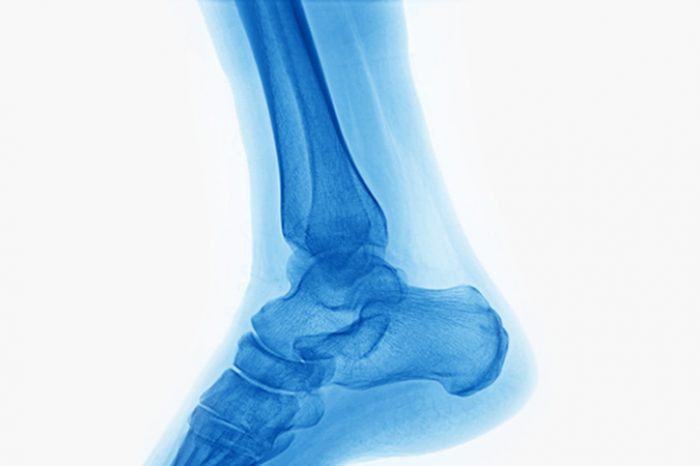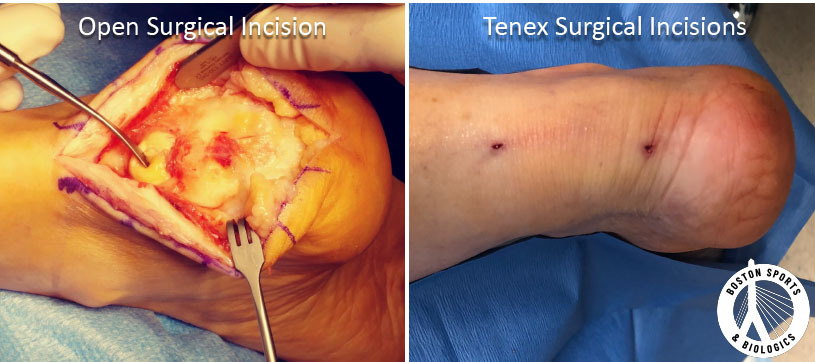
Achilles tendinopathy is a common cause of ankle pain, and platelet rich plasma (PRP) and percutaneous needle tenotomy with Tenex are increasingly being used to treat this condition.
The Achilles tendon is a strong fibrous tendon in the back of the ankle, that attaches the calf muscles (gastrocnemius and soleus muscles) to the heel (calcaneus). Injuries can range from tendonitis to a significant tear, but the majority of clinical diagnosis are tendinopathy (55% to 66% of cases).1, 2
Achilles tendon pain is typically categorized as insertional or mid-substance tears. Mid-substance Achilles tendinopathy is characterized by pain and swelling located between the calf muscle and the heel bone. It is prevalent among runners, but can also occur from trauma or overuse.
The focus of this post will be on mid-substance Achilles tendinopathy (for more on insertional Achilles tendinopathy and Haglund treatments click here).
There are 2 types of Achilles tendon injuries: and acute injury and chronic injuries. Each type of Achilles injury is treated differently
Acute injuries typically occur suddenly, and patients may hear a pop and feel a sharp pain in the back of the ankle. An acute injury can completely or partially tear the tendon. Partial Achilles tendon tears can often be treated with rest, ice, NSAIDs and supervised eccentric based physical therapy. Patients with severe pain may be treated with immobilization. Complete tears may require surgery.
Chronic Achilles tendinopathy typically presents gradually and the tendon can become thickened with fraying (small tears) to the middle of the tendon. Chronic injuries are typically due to overuse or repetitive stress, and a failure of the normal healing process resulting in the tendon being replaced with degenerative tissue.

Conservative treatment is the first line in managing non-insertional tendinopathy with good results. Treatments most often include a combination of rest, NSAIDs, heel lifts, shock-wave, stretching and strengthening exercises, but there is sparse evidence supporting the use of most treatments. Exercises and strengthening protocols are promising but need to be evaluated in larger trials.3
In cases that do not respond to therapy, invasive treatments like surgery are sometimes considered. In general, about 25% of these patients that have Achilles pain go on to have surgery.1 Open surgical decompression and minimally invasive procedures have been described. In general, minimally invasive techniques have a similar success rate and patient satisfaction to open surgery, but have less than half the complication rate (wound infections, skin edge necrosis and fibrotic scar formation).4, 5
In cases that fail conservative management, platelet-rich plasma (PRP) or percutaneous needle tenotomy (PNT) with Tenex could be an option. While these treatments are relatively new, they have a negligible side effect profile and a shorter recovery period when compared to more invasive surgery with a long recovery period.

PRP is a non-surgical procedure that uses a patient’s own concentrated platelets to stimulate a healing response. Platelets have various growth factors and molecules stored in their alpha granules that enhance healing at the cellular level to promote the natural healing process.
Many trials have been performed on different tendons, but few studies have examined the effectiveness of PRP in Achilles tendinopathy. A recent large review, including a total of 406 patients examined the role of PRP for mid-substance Achilles tendinopathy and found that patients treated with PRP had a meaningful functional improvement (VISA-A score).6A number of other reviews and meta-analyses have come to different conclusions,6, 7, 8, 9 but studies have varied in the type of PRP injected, site of the injection and rehabilitation.
Percutaneous needle tenotomy (PNT) is a simple procedure and has shown promising results in in the Achilles in small studies.10, 11, 12 Ultrasound guided percutaneous tenotomy with Tenex allows what was once a major surgery to be performed quickly through a small incision. The procedure involves making a small hole and advancing a needle under direct ultrasound guidance into the disease tendon. The procedure can be performed as an outpatient setting using local anesthetic.
Using the Tenex micro-tip to cut, break up and remove scar tissue. The procedure also triggers the healing cascade to ultimately repair the degenerated tendon. The percuatenous approach has several advantages to traditional surgery with either an open or endoscopic operative approach, including decreased cost, use of local anesthesia only, decreased opioid pain use and a quicker return to activity.
1. Kvist M. Achilles Tendon Overuse Injuries: A Clinical and Pathophysiological Study in Athletes [dissertation]. Turku, Finland: University of Turku; 1991.
2. Kvist M. Achilles tendon injuries in athletes. Sports Med. 1994;18:173-201.
3. Gatz M, Spang C, Alfredson H. Partial Achilles Tendon Rupture-A Neglected Entity: A Narrative Literature Review on Diagnostics and Treatment Options. J Clin Med. 2020;9(10):3380.
4. Lohrer H, David S, Nauck T. Surgical treatment for achilles tendinopathy - a systematic review. BMC Musculoskelet Disord. 2016;17:207. Published 2016 May 10. doi:10.1186/s12891-016-1061-4.
5. Paavola M, Kannus P, Orava S, Pasanen M, Järvinen M. Surgical treatment for chronic Achilles tendinopathy: a prospective seven month follow up study. Br J Sports Med. 2002;36:178-182.
6. Madhi MI, Yausep OE, Khamdan K, Trigkilidas D. The use of PRP in treatment of Achilles Tendinopathy: A systematic review of literature. Study design: Systematic review of literature. Ann Med Surg (Lond). 2020 Jun 1;55:320-326.
7. Liu CJ, Yu KL, Bai JB, Tian DH, Liu GL. Platelet-rich plasma injection for the treatment of chronic Achilles tendinopathy: A meta-analysis. Medicine (Baltimore). 2019 Apr;98(16):e15278.
8. Nauwelaers AK, Van Oost L, Peers K. Evidence for the use of PRP in chronic midsubstance Achilles tendinopathy: A systematic review with meta-analysis. Foot Ankle Surg. 2020 Jul 30:S1268-7731(20)30163-6.
9. Wang Y, Han C, Hao J, Ren Y, Wang J. Efficacy of platelet-rich plasma injections for treating Achilles tendonitis : Systematic review of high-quality randomized controlled trials. Orthopade. 2019 Sep;48(9):784-791.
10. Chraim M, Alrabai HM, Krenn S, Bock P, Trnka HJ. Short-Term Results of Endoscopic Percutaneous Longitudinal Tenotomy for Noninsertional Achilles Tendinopathy and the Presentation of a Simplified Operative Method. Foot Ankle Spec. 2019 Feb;12(1):73-78.
11. Maffulli N, Testa V, Capasso G, Bifulco G, Binfield PM. Results of percutaneous longitudinal tenotomy for Achilles tendinopathy in middle- and long-distance runners. Am J Sports Med. 1997 Nov-Dec;25(6):835-40.
12. Testa V, Capasso G, Benazzo F, Maffulli N. Management of Achilles tendinopathy by ultrasound-guided percutaneous tenotomy. Med Sci Sports Exerc. 2002 Apr;34(4):573-80.
Adductor longus selective tenotomy is a modern surgical treatment for chronic groin pain that offers faster recovery and better outcomes than traditional full release surgery. The adductor longus, an inner thigh
Read MoreDiscover how ultrasound helps diagnose plantar fat pad atrophy, a leading cause of ball-of-foot pain. Learn about symptoms, thickness cutoffs, and why early detection matters for relief.
Read More